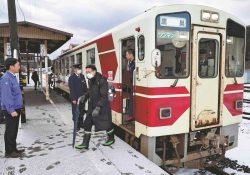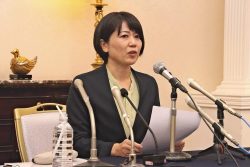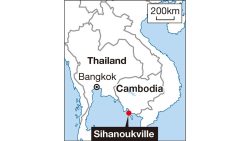
The Kaze no Obisashi eaves can be seen in the upper part of the exterior of the National Stadium, the main venue of the Tokyo Olympics and Paralympics, in Shinjuku Ward, Tokyo.
10:14 JST, July 20, 2021
Strict measures to avoid the spread of the coronavirus will be taken during the Tokyo Olympics, the first time the sporting spectacle will be held in Japan’s capital since the 1964 Games. Another threat is the summer heat, and various efforts are being made behind the scenes using high-tech cooling devices and systems to protect athletes, staff and visitors from suffering heatstroke.
Ultrafine cooling mist
The term “uchimizu” refers to a traditional cooling method widely practiced in Japan of people sprinkling water on the streets to ease the summertime heat. The act was a popular theme referenced in haiku poems and depicted in ukiyo-e woodblock prints during the Edo period (1603-1867). Even today, sprinkling water is done as a token to welcome guests.
Uchimizu has a cooling effect due to the water evaporating.
A modern version of uchimizu is artificially generated mist. Water particles 20 to 35 micrometers (a micrometer is one-millionth of a meter) in size are sprayed to lower the temperature as heat dissipates. However, if the water particles are too large, people will get wet.
Panasonic Corp. has solved that problem by developing a new mist-generation system, and one has been installed in the plaza in front of JR Shimbashi Station in Tokyo.
Special nozzles generate water particles as small as 6 to 10 micrometers in size. The system makes people feel cool, but not wet. According to Panasonic, a person senses air that is about 7 C cooler.
The system has also been installed in Odaiba along Tokyo Bay, where the triathlon will be held.
“Spraying mist has a strong cooling effect that consumes little power,” said an official of Panasonic. “We have high hopes that it will be suitable for the infrastructure of future cities.”
Rising temperatures
Compared to 1964, the average temperature in Japan has risen by about 1 C, and in Tokyo by about 2 C. The larger increase in Tokyo is attributed to the heat island effect of urban areas, which is caused by large amounts of heat being discharged by cars and buildings that gets absorbed and re-emitted by asphalt and cement covering the ground.
The annual number of deaths from heatstroke in Japan has exceeded 1,000 for three consecutive years. In 1964, the figure was 86.
Sporting goods maker Descente Ltd. has developed a glove made with cooling material. The product maintains a temperature of 12 C for 20 minutes to lower a person’s body temperature through the blood vessels in the palm.
Wrapping a wet towel around one’s neck is also helpful.
The most effective countermeasure is “to avoid being exposed to sunlight and storing heat in the body as much as possible,” said Prof. Ikusei Misaka, a specialist of architectural environment engineering at the Nippon Institute of Technology.

Searching for shade
In Tokyo’s summer heat, shade is an oasis.
A group of companies and researchers called Green Tokyo Kenkyukai last summer developed an online system called Tokyo Oasis that allows smartphone users to search for routes with lots of shade and shadows so they can be cool while walking, even when wearing a mask amid the coronavirus pandemic.
A similar system will be provided again this summer.
The system saves information in a database on the heights of buildings and trees covering about 120 hectares of the Otemachi, Marunouchi and Yurakucho districts in Tokyo to calculate shaded and shadowy areas every hour based on the movement of the sun.
When a user searches for a route from their current location to an “oasis spot” with much greenery and other refreshing elements, a map will show a path that goes through shaded areas.
Parasols also have a cooling effect. Toray Industries, Inc. developed Summer Shield, a three-layered fabric used with a parasol that achieves 100% light-shielding and 99% ultraviolet protection properties.
According to the company, the parasol reduces the temperature by about 4 C compared to ordinary parasols. The material was also used for some of the spectators’ tents at the pre-Olympic triathlon competition.
The heat is getting more intense every year. It is unrealistic not to care about the temperature and just cite a famous Zen saying to the effect of: Clear your mind, and you will find even fire cool. Instead, we should wisely use advanced technologies to survive the heat.
Harnessing the wind
The National Stadium in Shinjuku Ward, Tokyo, which will be the main venue for the Olympics and Paralympics, was designed with an emphasis on alleviating heat.
“We designed the stadium by taking wind into consideration,” said Taisei Corp.’s Hisao Kawano, who was in charge of designing the stadium.
As air-conditioning devices cannot be installed in the stadium, the design team focused on the southeasterly wind that becomes stronger in the area in the summer.
The large Kaze no Obisashi eaves built in the upper stands are designed to guide the wind into the stadium and allow the airflow to carry away the heat and moisture of the field and spectators’ seating area. However, in the winter, the design blocks the cold wind blowing from the northwest.
Kawano and his team divided the large eaves into 17 sections and then performed 1,000 simulations for each section to determine the appropriate spacing of the wood. Good ventilation also helps prevent the spread of the coronavirus.
“A stadium reflects the times and society when it was built,” Kawano said. “I’m also glad we were able to make it harmonize with the forest of Meiji Jingu shrine nearby.”
"Society" POPULAR ARTICLE
-

M4.9 Earthquake Hits Tokyo, Neighboring Prefectures
-

M7.5 Earthquake Hits Northern Japan; Tsunami Waves Observed in Hokkaido, Aomori and Iwate Prefectures
-

Tsukiji Market Urges Tourists to Avoid Visiting in Year-End
-

Beloved Cat Stationmaster Nitama in Wakayama Pref. Passes Away at 15
-

M5.7 Earthquake Hits Japan’s Kumamoto Pref., Measuring Upper 5 Intensity, No Tsunami Expected
JN ACCESS RANKING
-

Keidanren Chairman Yoshinobu Tsutsui Visits Kashiwazaki-Kariwa Nuclear Power Plant; Inspects New Emergency Safety System
-

Imports of Rare Earths from China Facing Delays, May Be Caused by Deterioration of Japan-China Relations
-

Japan Exports Rise in October as Slump in U.S. Sales Eases
-

Govt Aims to Expand NISA Program Lineup, Abolish Age Restriction
-

Blanket Eel Trade Restrictions Rejected

























